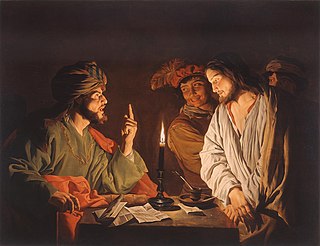
Herod Agrippa, also known as Herod II or Agrippa I, was the last Jewish king of Judea. He was a grandson of Herod the Great and the father of Herod Agrippa II, the last known king from the Herodian dynasty. He was acquaintance or friend of Roman emperors and even played crucial roles in internal Roman politics.
Annas was appointed by the Roman legate Quirinius as the first High Priest of the newly formed Roman province of Judaea in AD 6 – just after the Romans had deposed Archelaus, Ethnarch of Judaea, thereby putting Judaea directly under Roman rule.

James the Just, or a variation of James, brother of the Lord, was a brother of Jesus, according to the New Testament. He was the first leader of the Jerusalem Church of the Apostolic Age. Traditionally, it is believed he was martyred in AD 62 or 69 by being stoned to death by the Pharisees on order of High Priest Ananus ben Ananus. James, Joses, Simon, and Judas are mentioned as the brothers or siblings of Jesus as well as two or more unnamed sisters.

Josef Ben Caiaphas, known simply as Caiaphas in the New Testament, was the Jewish high priest during the years of Jesus' ministry, according to Josephus. The Gospels of Matthew, Luke and John indicate he was an organizer of the plot to kill Jesus. He famously presided over the Sanhedrin trial of Jesus. The primary sources for Caiaphas' life are the New Testament, and the writings of Josephus. The latter records he was made high priest by the Roman procurator Valerius Gratus after Simon ben Camithus had been deposed.

The First Jewish–Roman War, sometimes called the Great Jewish Revolt, or The Jewish War, was the first of three major rebellions by the Jews against the Roman Empire fought in the province of Judaea, resulting in the destruction of Jewish towns, the displacement of its people and the appropriation of land for Roman military use, as well as the destruction of the Jewish Temple and polity.

Theophilus was the High Priest in the Second Temple in Jerusalem from 37 to 41 CE according to Josephus's Antiquities of the Jews. He was a member of one of the wealthiest and most influential Jewish families in Iudaea Province during the 1st century. A growing but still uncommon belief points to High Priest Theophilus as the person to whom the Gospel of Luke is addressed, but Theophilus is a common enough name that there are many other possibilities for the addressee of Luke's Gospel and the Acts of the Apostles. In its favor is the fact that in Luke Theophilus is called by the title Most Excellent (kratiste), indicating he held a political office like high priest, the ethnarch under the Romans. In Acts 1:1 he does not have this honorific indicating that he no longer held an office of the Roman government. This provides an unusual identifier that eliminates other candidates for whom such a change in office was not effected.

The priesthood of Melchizedek is a role in Abrahamic religions, modelled on Melchizedek, combining the dual position of king and priest.
Eleazar ben Simon was a Zealot leader during the First Jewish-Roman War who fought against the armies of Cestius Gallus, Vespasian, and Titus Flavius. From the onset of the war in 66 CE until the destruction of the temple in 70 CE, he fought vehemently against the Roman garrisons in Judea and against his fellow Jewish political opponents in order to establish an independent Jewish state at Jerusalem. Although the Jewish defeat at Jerusalem cannot be entirely attributed to Eleazar ben Simon, his inability to establish unity with John of Gischala and Simon bar Giora resulted in a bitter civil war that weakened the Jewish resistance against Rome. Eleazar ben Simon and his Zealots' radical anti-Roman policies and eradication of the moderate temple aristocracy from Jerusalem in 67 CE also prevented any peaceful agreement with Rome to avoid the death and destruction which ensued in 70 CE.

In Judaism, the High Priest of Israel was the head of the Israelite priesthood. He played a unique role in the worship conducted in the Tabernacle and later in the Temple in Jerusalem, as well as in some non-ritual matters. Like all priests, he was required to be descended from Aaron. But unlike other priests, the high priest followed more restrictive laws, wore unique priestly garments, and was the only priest allowed to perform certain ceremonies.
Joshua ben Gamla, also called Jesus the son of Gamala, was a Jewish high priest in about 64-65 CE. He was killed during the First Jewish–Roman War. While the Talmud refers to Joshua ben Gamla, the earlier Greek works of Josephus Flavius call him Γαμάλα μὲν υἱὸς Ἰησοῦς a semitism for: The son of Gamala, Jesus.
Valerius Gratus was the 4th Roman Prefect of Judaea province under Tiberius from 15 to 26 CE.

Herod of Chalcis, also known as Herod Pollio King of Chalcis, Herod V, and listed by the Jewish Encyclopedia as Herod II, was a son of Aristobulus IV, and the grandson of Herod the Great, Roman client king of Judaea. He was the brother of Herod Agrippa I and Herodias and ruled as the king of Chalcis in 41–48 CE.
Lucceius Albinus was the 6th Roman Procurator of Judea from 62 until 64 and the governor of Mauretania Tingitana from 64 until 69.
Ananus ben Ananus was a Herodian-era High Priest of Israel in Jerusalem, Judea Province. He was the High Priest who ordered the execution by stoning of James, the brother of Jesus, according to the Antiquities of the Jews of Josephus. A delegation sent by citizens upset over the perceived breach of justice met Lucceius Albinus before he reached Judea, and Albinus responded with a letter informing Ananus that it was illegal to convene the Sanhedrin without Albinus' permission and threatening to punish the priest. Ananus was therefore deposed by King Herod Agrippa II before Albinus's arrival and replaced with Jesus ben Damneus.

The Zealot Temple siege was a short siege of the Temple in Jerusalem fought between Jewish factions during the First Jewish–Roman War. According to the historian Josephus, the forces of Ananus ben Ananus, one of the heads of the Judean provisional government and former High Priest of Israel, besieged the Zealots who held the Temple. When John of Gischala led the Zealots to believe that Ananus had contacted the Roman general Vespasian for assistance in retaking control of all Jerusalem, the Zealots, driven to desperation, asked the Edomites (Idumeans) for assistance in preventing the delivery of the city to the Romans. When the Edomites arrived, the Zealots opened the gates of Jerusalem to them, and the Edomites slaughtered ben Hanan's forces, killing him as well.

Jesus son of Damneus was a Herodian-era High Priest of Judaea in Jerusalem, Iudaea Province.
Joseph ben Gurion was according to Josephus one of the chief leaders of the First Jewish–Roman War, which erupted in the year 66 in Roman Judea. Along with Ananus ben Ananus, ben Gurion was heading the Judean provisional government (66–68), formed in the aftermath of the Battle of Beth Horon (66). Ben Gurion was killed in the year 68 during the carnage of the Zealot Temple Siege.









